A Day Among the Clouds
Hiking Mount Katahdin alongside Appalachian Trail thru-hikers
I reach to shake the hand of a white-bearded hiker, but he instead extends a fist.
“We do it like this around here, you know, for sanitary reasons,” he tells me before we bump fists. “My name’s Hollywood. Or Tom. Hollywood Tom. Whatever you’d like.” “Hollywood” is a trail name bestowed on Tom by fellow thru-hikers on the Appalachian Trail in a practice that is at once a piece of levity and a deadly serious tradition. Trail names are never chosen by the hikers themselves, nor do hikers have much say in when, where, or how their name manifests. However, the new identity is there to stay, for as long as its bearer can stand to walk the trail.

Tom Merwarth, Sr., called “Hollywood” on the AT, admires the vista atop the final, rocky challenge of his nearly-seven-month journey along the AT. 
Photographer Aimee Bartee makes her way past the aptly named “camel’s hump.”
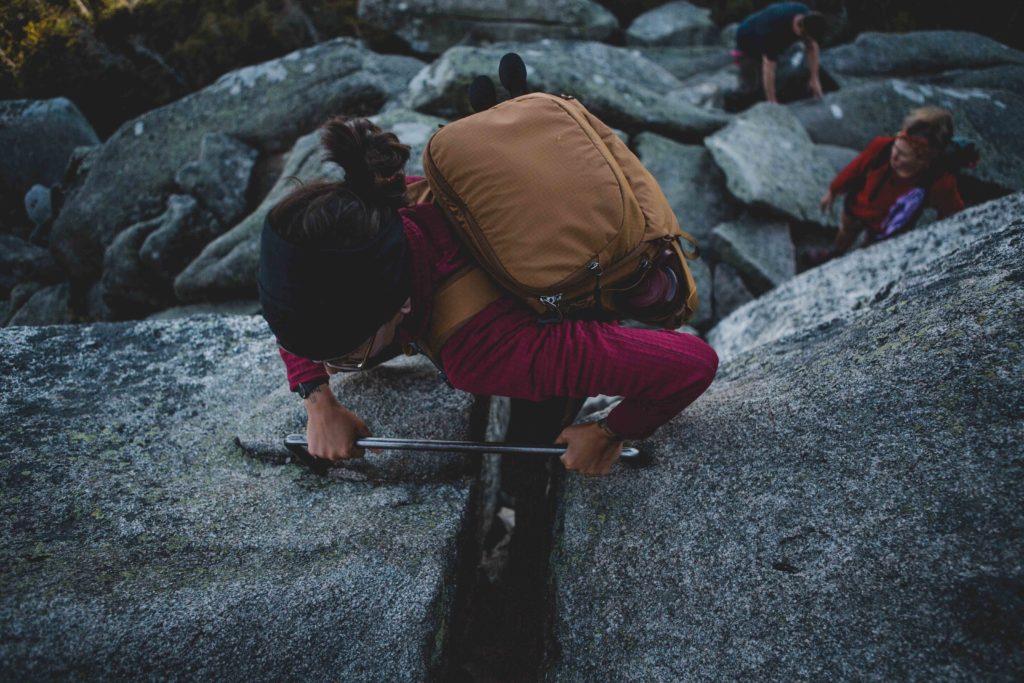
The final ascent of the AT is not for the faint of heart. Moderate- to advanced-level bouldering is required to reach its northern terminus.
Hollywood is a stout man, with kind yet mischievous blue eyes and a beard that obscures most of his face. His body is hard and rough, like the striated granite outcropping we are huddled on, and his calves show muscles and tendons I don’t recognize on my own legs. My wife, Aimee Bartee, and I are standing halfway up Maine’s tallest peak, named Katahdin, which means “The Greatest Mountain,” by the Penobscot people long ago. I gaze out to the endless greens, ochres, and rusty reds of Baxter State Park in early autumn. Small lakes interrupt the thick forest in a way Thoreau once likened to a “mirror broken into a thousand fragments, and wildly scattered over the grass, reflecting the full blaze of the sun.” It feels a long way from the inky black and chilly morning at Katahdin Stream Campground when we embarked.
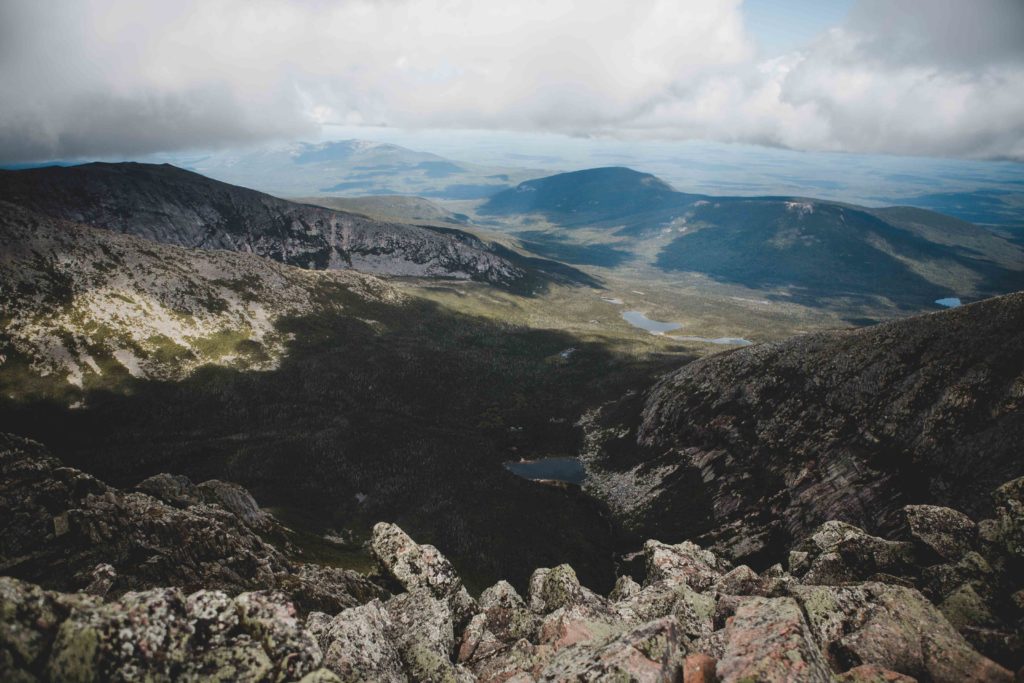
Looking out from the summit of Mount Katahdin.
Looking down at the mottled scree fields below, I can make out a handful of small dark shapes weaving paths among the boulders. We are hiking with a group of at least 20, most of whom are climbing the final stretch of their 2,200-mile trek from Georgia to Maine. Some are alone and have been for the duration of their hike through 14 states, while others remain in tightly knit groups. One woman who hiked the length of the trail in solitude is now joined by her husband, who couldn’t make the rest of the journey with her but is here for her final push to the top. Despite individual and varied approaches, there is a sense of camaraderie on the mountain: a collective of people of diverse ages and backgrounds giving cooperative encouragement and support toward a common goal.
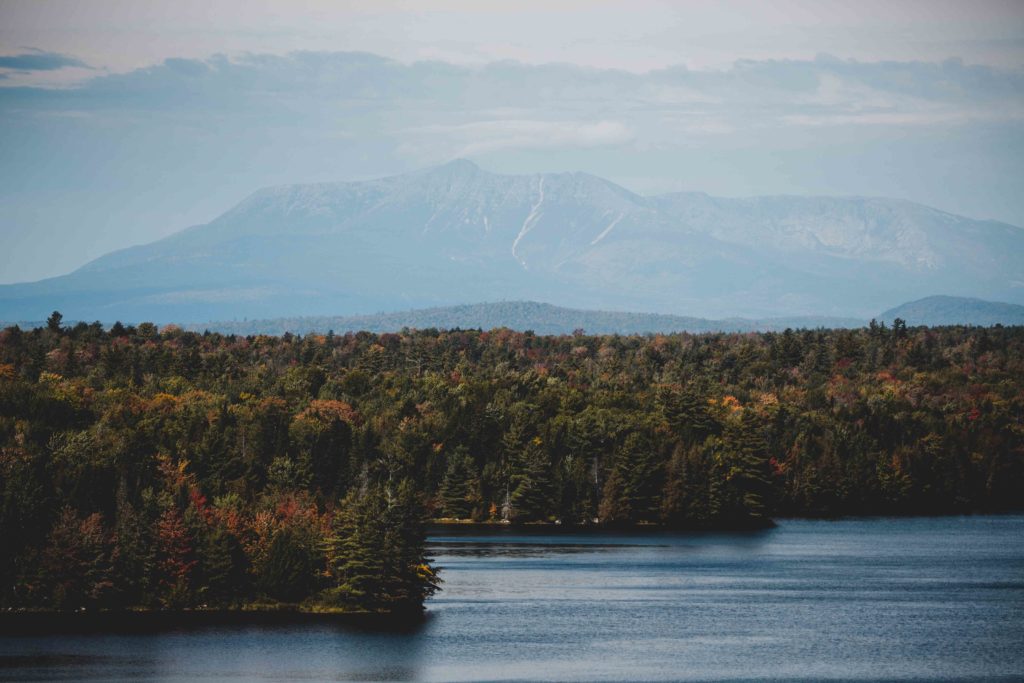
The crown jewel of Baxter State Park: Katahdin rises more than 4,000 feet from the forested hills below.
Today the Appalachian Trail and its colorful characters are often featured in popular literature and entertainment, and for those who live in the many towns the trail crosses, unshaved faces and legs and heavy packs are staples of summertime eateries and lodging. But that wasn’t always the case. In 1921 a middle-aged forester and conservationist named Benton MacKaye first presented the idea for a walking path from Georgia to Maine, although it would take the better part of a decade before he would scrape together enough like-minded individuals to break ground. MacKaye envisioned a series of sovereign utopian towns dotting the length of the trail, supported by privately owned farm and food camps. He would later abandon his work on the AT after a series of disagreements between him and his primary partner, Myron Avery. A lawyer from Washington, D.C., and a Bowdoin College alumnus, Avery approached the trail as an opportunity to make the mountains accessible to the masses, an idea that clashed with MacKaye’s ideals.
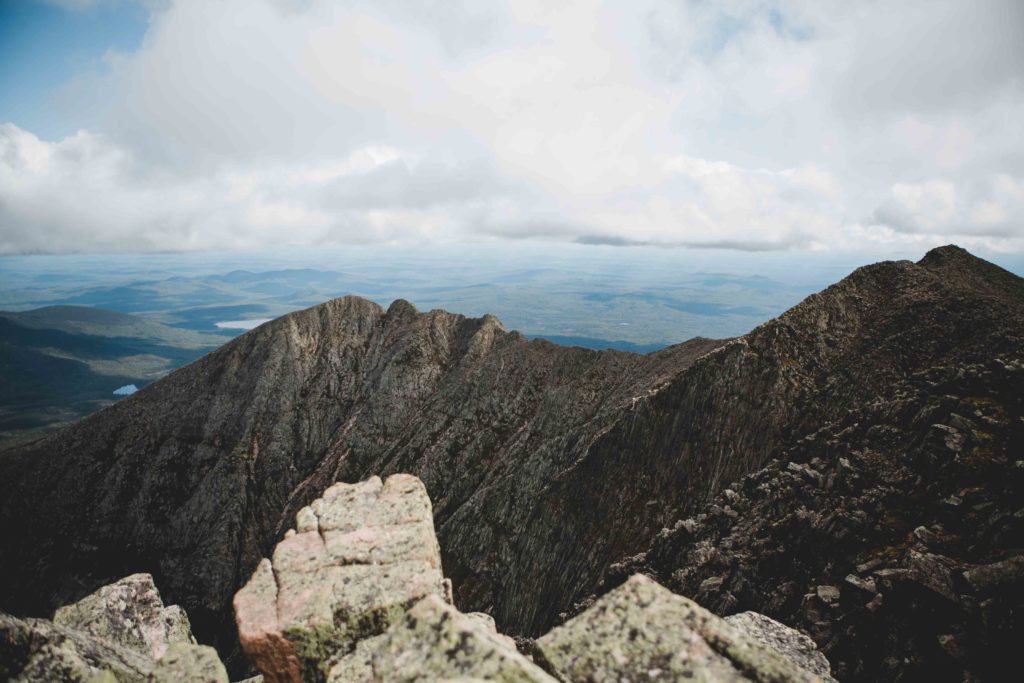
Looking east from Baxter Peak, the magnificent and daunting Knife Edge Trail can be seen slicing its way through the sky.
On August 14, 1937, the Appalachian Trail was officially completed, but the story didn’t end there. The following year, Congress approved an extension of the Blue Ridge Parkway, which would displace nearly 120 miles of trail, and a hurricane damaged large swaths in the north. A myriad of conflicts began to develop with private landowners, and attempts to resolve them, along with maintenance and repair work, ground to a halt as the efforts of volunteers were refocused on the effects of World War II. It would take another ten years before a WWII veteran named Earl Shaffer would breathe new life into the Trail by becoming the first person on record to hike its length, a feat that at the time was believed to be impossible. Today, over 20,000 people have successfully thru-hiked the trail. In 1968, after 20 years of continued effort to construct and solidify the route, Lyndon B. Johnson signed the National Trails System Act into law, making the AT the first federally recognized and protected national scenic trail. The process of officially acquiring all the land the Trail inhabits would take half a century, not formally completed until 2014. The Appalachian Trail Conservancy (ATC) estimates that since the Trail’s inception, as much as 99 percent of it has been moved or reconstructed—a story that is still being written to this day, with as many as a quarter million volunteer hours put toward its continued maintenance each year.

Katahdin’s tablelands are an otherworldly landscape, home to many rare forms of life, some found nowhere else on Earth.
Today more than 3,000 people attempt to thru-hike the AT each year, but fewer than a quarter of them complete the trek. Our new trail companion, Hollywood, began his journey in Georgia in early spring to celebrate turning 70 this year. Just before his trip, his neighbor killed his dog, he tells me and Aimee. “I had a pretty aggressive pit bull, and one day my neighbor had had enough and shot the dog,” he says. “I figured with nothing left weighing me down at home that needed taking care of, I might as well get going.” Like many of the people on the trail that day, Hollywood’s story felt both expected and inexplicable, coming from a person who set aside half a year to go walking. He regales us with tales of his past, including a career in the floral industry where he made arrangements for a Saudi prince’s wedding and annual cross-country motorcycle rides from his home in North Carolina to Vancouver. Once he completes the AT, he plans to head to India to hike the Himalayas and visit Buddhist temples. After telling us he’ll see us at the top, he reaches up to grab a single iron rung that looks as if it’s been placed in a large granite boulder with a giant staple gun and, with astounding flexibility, swings his right heel up above his shoulder and ratchets himself over the stones and out of sight. As Aimee and I prepare to follow suit, Hollywood’s head pops back out of a small nook in the boulders, some 20 feet above us. “By the way,” he shouts down. “You wanted to know why I’m walking the Trail? It’s to grow my spiritual practice.” He pauses for a moment and stares out over the sea of trees below us. “Yeah, that’s it.” And with that, he once again vanishes into the maze of ancient stones.

The AT is filled with stream crossings, large and small. 
Although Katahdin can be hiked as a day trip, it’s part of the 2,200-mile network of trails that make up the AT.
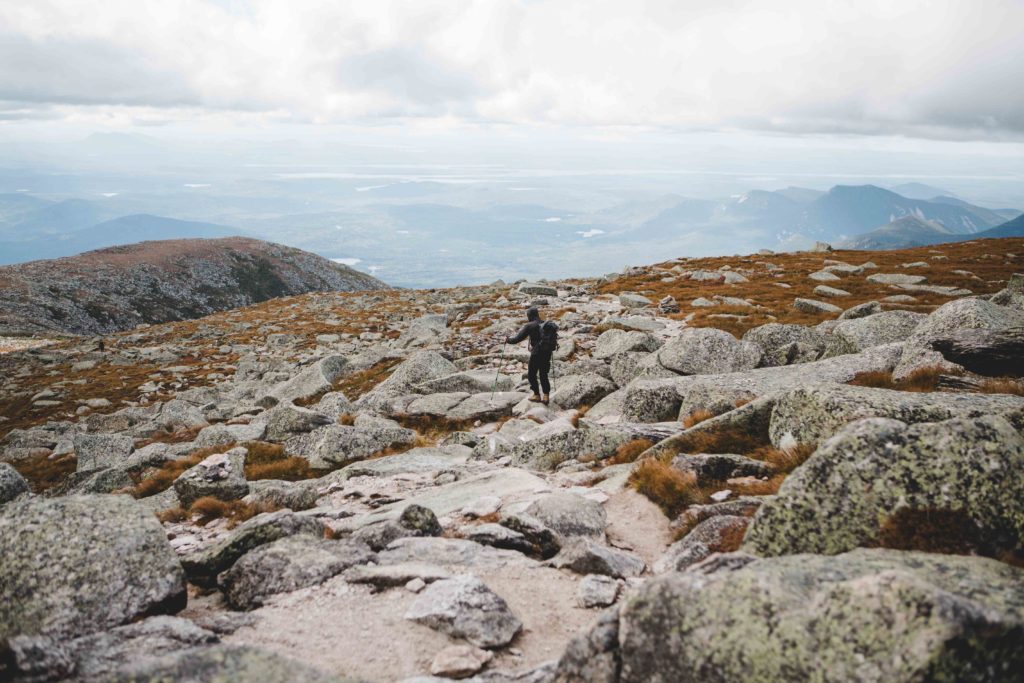
With 360-degree views of the North Woods, keeping your eyes on the trail can be a challenge.
Over the next hour we climb, scramble, scale, and skip our way through the challenging rocky terrain, more than once having to overcome waves of doubt. With each step the climb seems to increase in steepness, and every rise leads to another false summit. Earlier this morning a slippery log crossing over the tumbling waters of Katahdin Stream had seemed like a daunting challenge, but now the trail has redefined what it means to push ourselves. Rounding a corner, we finally catch a glimpse of where we are headed. A massive rocky spine rises up like the back of some giant prehistoric creature, with bending wispy tendrils of condensation around it like massive cotton-candy fingers. Known as the “camel’s hump,” this humbling structure is the stairway to Katahdin’s tablelands, an otherworldly and desolate landscape in sharp contrast to the spruce forest below. As we ascend farther into the clouds, we are overtaken by group after group of hikers, all wearing packs adorned with a small fire-engine-red tag with the official AT logo, a sign that they are registered thru-hikers. “I think we’re about here,” I say to Aimee while pointing at the map, then am discouraged to find that the past few hours can be fully obscured by the width of my fingertip. “Probably another mile or two to go.” After we make it over the next ridge, we see the summit. With renewed energy, we forge ahead through the alpine barrens. The upper reaches of Katahdin are host to dozens of species of flora and fauna more commonly found in arctic tundra, including a critically endangered butterfly species found nowhere else on Earth. Signs caution hikers not to stray from the trail at risk of damaging the small lichens and shrubs on the moonlike surface.

At the end of a several-months-long journey, thru-hikers reminisce and celebrate their accomplishments.
Our final stretch to the summit of Baxter Peak is blessed with bluebird skies, warm sun, and a slow, cool breeze. At the top we find a host of familiar characters, now jovially chatting, embracing, and snacking in the afternoon rays. Politely waiting their turn, each hiker makes their way to pose for a photo next to a well-worn sawhorse and wooden plaque denoting the 5,267-foot-high northern terminus of the Appalachian Trail. Around us is a 360-degree view of Baxter State Park, perhaps the crown jewel of Maine’s North Woods. Legs burning and hearts pounding, we revel in our personal accomplishment, and for a moment I understand what Hollywood meant. We’re often consumed by a relentless urge to measure our lives in linear improvement, but here, at what feels like the top of the world, time and space are momentarily suspended as the individual paths all merge into one. It no longer matters who started where, or where they are headed next, only that we are all here in this moment. I won’t remember very much of my hike down. What will matter most is that all our spirits have grown.

AT thru-hikers are easily distinguished from others on the trail, by the official red emblem of the AT and by their quick pace and hardened trail legs.

